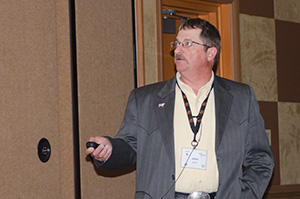Producer Application Committee:
Current Uses of Gender-selected Semen
Sexed semen can be a tool for genetic improvement with many uses.
by Kasey Brown, associate editor, Angus Journal®
OKLAHOMA CITY, Okla. (June 13, 2013) — Gender-selected semen may seem like a technology for the future, but there are many uses for it now with improving results, said John Hall, University of Idaho, to participants of the 45th Annual Beef Improvement Federation Research Symposium and Convention in Oklahoma City June 12-15.

Where there was no sexed semen available on beef bulls in 2008, gender-sorted semen is available on nearly 130 beef bulls through bull studs and the company Sexing Technologies, said John Hall, University of Idaho.
Gender-selected semen is much more widely used in the dairy industry, but beef producers are starting to use the technology. Where there was no sexed semen available on beef bulls in 2008, gender-sorted semen is available on nearly 130 beef bulls through bull studs and the company Sexing Technologies.
Success rates have tended to be 35%-40% with gender-selected semen in fixed-time artificial insemination (FTAI) programs. That used to be the success rate for conventional semen in an FTAI program. With advancements in technology, pregnancy rates to conventional FTAI currently average 55%-65% — 10%-20% better than with gender-sorted semen. The lower pregnancy rates have been a deterrent to using gender-sorted semen, but research indicates improvement is coming.
Hall shared research that indicated using gender-selected semen after detected estrus is best, and FTAI is feasible. There is still a 10%-20% decrease in pregnancy rates compared to conventional semen, with greater variability in success. However, there is similar fertility in postpartum cows and heifers; and gender-selected calves perform the same as calves from conventional AI.
Use of gender-selected semen in embryo transfer (ET) has been discouraged by the semen-sexing industry. Hall reported that there is a 20%-35% reduction in transferable embryos. Hower, even though fewer embryos are obtained with gender-sorted semen compared to conventional semen, the embryos are 90% of the desired gender. Therefore, fewer recipients are needed and fewer animals of the undesired gender are produced.
In vitro fertilization (IVF) with gender-selected semen has resulted in pregnancy rates of 30%-50%. Pregnancy rates have been shown at 36%-40% even when shipped during culture.
Another option is called reverse sorting. This sorts previously frozen semen by gender, which can allow production of gender-selected semen from bulls no longer producing semen. He said it is generally used for IVF.
The most exciting use for gender-selected semen, Hall said, is to produce maternal lines to be mated to terminal lines, a practice which is limited in beef cattle compared to other meat animals. Producing maternal lines by means of replacement heifers would be quicker and use fewer resources with use of gender-selected semen.
Gender ratios could also shift with use of gender-selected semen given the desires of the operation. Seedstock applications include using Y-sorted semen for bull production, and X-sorted semen for replacement heifer production or enhancing female lines. Commercial operations can use it to create a marketing advantage by producing more steers for a uniform trailer load and to meet specific customer needs.
“Sexed semen is a technology whose time has come in the beef industry; however, producers need to understand the risks and limitations,” he concluded.
Return to the Newsroom for links to the PowerPoint and audio for this presentation.
-----------------------------------------Editor’s Note: This summary was written under contract or by staff of Angus Productions Inc. (API). Through an agreement with the Beef Improvement Federation, we are encouraging reprinting of the articles to those who will adhere to the reprint guidelines available on this site. Please review those guidelines or contact Shauna Rose Hermel, editor, at 816-383-5270. PowerPoints are posted with permission of the presenter and may not be reproduced in whole or in part without the express permission of the presenter.
API's coverage of the event is made possible through collaboration with BIF and sponsorship of LiveAuctions.tv. For questions about this site, or to notify us of broken links, click here.
Headquartered in Saint Joseph, Mo., API publishes the Angus Journal, the Angus Beef Bulletin, the Angus Beef Bulletin EXTRA, and the Angus Journal Daily, as well as providing online coverage of events and topics pertinent to cattlemen through the Angus Journal Virtual Library.



